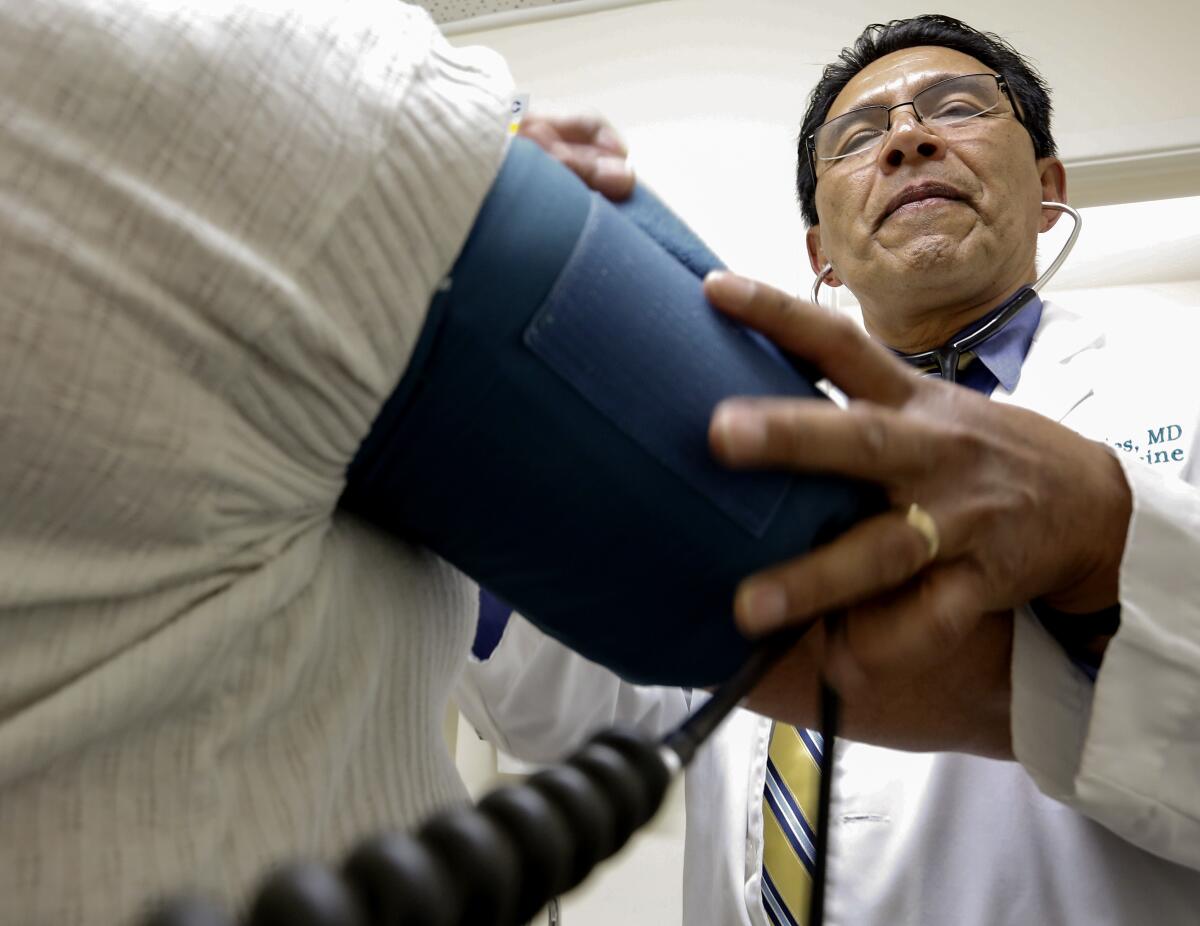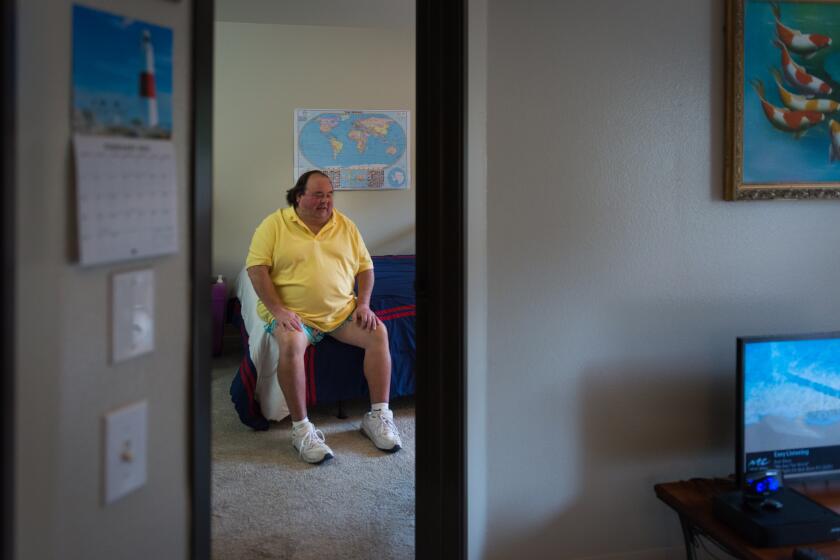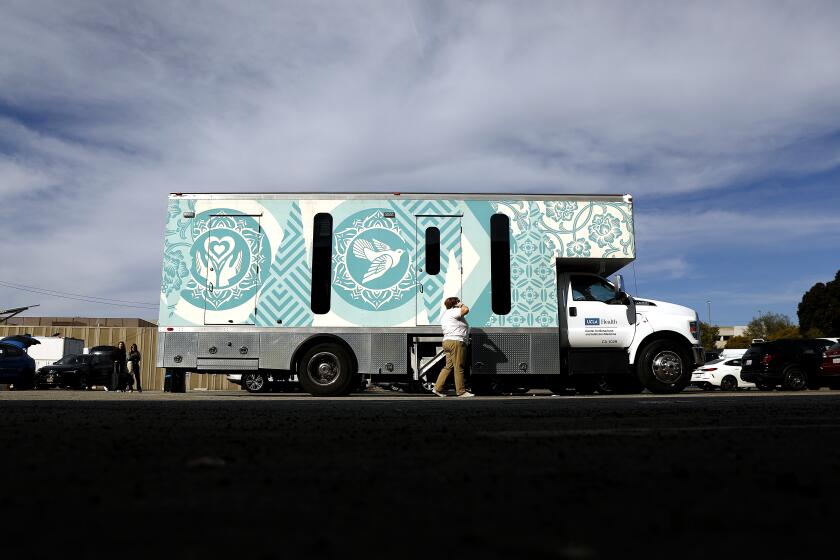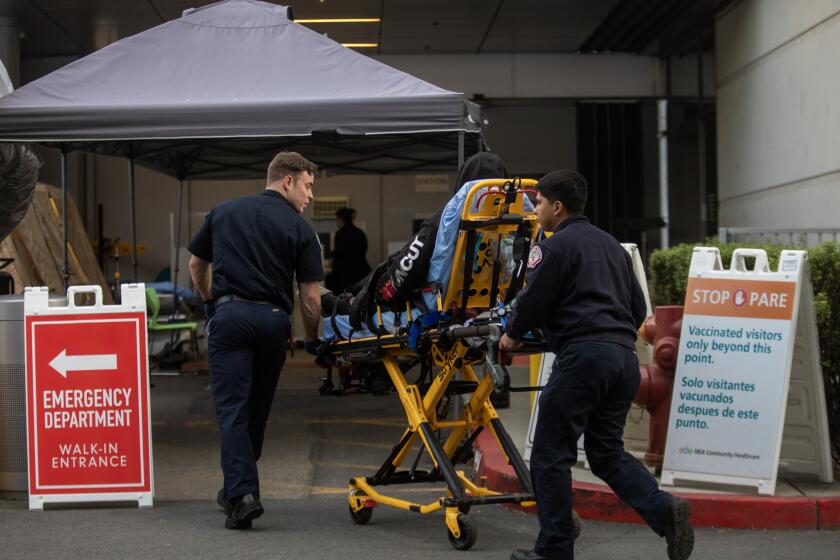Medi-Cal will soon end some people’s benefits. What this means for you

- Share via
Since the COVID-19 pandemic began in earnest, low-income Californians who enrolled in Medi-Cal — California’s version of the government-funded Medicaid health insurance program — have been able to keep their coverage without having to prove every year that they still qualified for it.
That’s because the Families First Coronavirus Response Act, which President Trump signed into law in March 2020, offered states extra money if they stopped booting people off Medicaid. And all but a handful of states complied.
In December, though, Congress ended the “continuous coverage requirement” as of March 31, giving states 14 months to restart the annual eligibility checks and trim their Medicaid rolls. Some states plan to begin culling enrollees this month, although California won’t start disqualifying people until July 1.
The risk, analysts say, is that many eligible people will be kicked off Medicaid because they didn’t receive or didn’t understand the state’s request for information about their circumstances. The Kaiser Family Foundation has estimated that 5 million to 14 million Americans will fall off the Medicaid rolls at least temporarily.
If you’re on Medi-Cal (or caring for someone who is), keep an eye out for a letter from county officials asking for the information needed to determine your eligibility. But don’t panic if you don’t get one right away, said Louise Norris, a health policy analyst for healthinsurance.org; the state plans to spend more than a year on eligibility checks.
Here’s an explanation of what’s happening and what options current Medi-Cal enrollees will have.
Gov. Gavin Newsom is making a bold push for Medicaid health plans to provide more housing support. He argues it’s cheaper to pay for rent than to allow homeless people to fall into crisis.
Is the government cutting Medicaid?
Not exactly, although the changes happening now across the country will probably reduce the program’s cost.
During the pandemic, the number of Medicaid enrollees swelled in California (by about 20%, to 15.5 million in December) and nationwide (by about 30%, to 92 million in November). The percentage of uninsured Americans dropped over that same period — a rare occurrence in the wake of an economic downturn.
The increase in Medicaid enrollees stemmed in part from the job losses and other economic disruptions caused by the response to the pandemic, but also from the pause in eligibility redeterminations.
Here’s a good illustration. States allow women who are pregnant to qualify for Medicaid at higher income levels. According to the Commonwealth Fund, though, a new mother can lose her benefits a few months after giving birth if her income exceeds the lower limit for nonpregnant enrollees. In Texas, for example, the income limit for pregnant women is about twice the federal poverty level; for nonpregnant parents, the Commonweath Fund says, it’s 16% of the poverty line — “a level that disqualifies almost all adults.” The COVID-19-era continuous coverage requirement let those mothers stay on Medicaid, but when that policy ends, their coverage will end too unless their income drops.
Medicaid’s growth came at taxpayers’ expense, given that Medicaid is jointly funded by federal and state governments. Total Medicaid costs rose 7% to 12% in each of the last three years as enrollment surged, the Kaiser Family Foundation estimated.
Checking eligibility again will bring the numbers down, in large part by excluding families whose current incomes are above the Medicaid limit. But it will also restart the costly and inefficient churning caused when qualified people are kicked off for failing to respond to a request for information about their income. That’s been a consistent problem for Medicaid, analysts say, although its prevalence is hard to measure.
The California Department of Health Care Services estimates that 2 million to 3 million Medi-Cal enrollees could lose coverage as a result of income determinations — some because they no longer qualify, but many because the department has lost contact with them. Nationally, the U.S. Department of Health and Human Services estimates that nearly 15 million people will lose Medicaid coverage, more than 40% of them because of “eligibility redetermination errors.”
To try to reduce that number, the state is enlisting “DHCS Coverage Ambassadors” from diverse groups to try to reach Medi-Cal enrollees “in culturally and linguistically appropriate ways.” If you’re interested in becoming an ambassador, you can learn more about the program at the coverage ambassadors’ English or Spanish websites.
Hepatitis C can be cured in most cases with a few months of medication. The number of Medi-Cal patients getting the treatment dropped during the pandemic.
Will millions of people go uninsured?
Potentially, yes.
Many who fall through the bureaucratic cracks will re-enroll automatically the next time they’re in the hospital. The bigger effect, Norris said, will be on people who unwittingly lose their coverage, then get turned away trying to refill a prescription or at a doctor’s appointment. They’ll have to put off care until they successfully re-enroll.
That may seem like a minor inconvenience, but there are real costs, healthcare analysts say.
“Research shows that disruptions in Medicaid coverage are common and often lead to periods of uninsurance, delayed care, and less preventive care for beneficiaries,” a report from the Department of Health and Human Services’ Office of the Assistant Secretary for Planning said. “Studies indicate that beneficiaries moving in and out of Medicaid coverage (sometimes called “churning”) results in higher administrative costs, less predictable state expenditures, and higher monthly health care costs due to pent-up demand for health care services.”
Many of the people who drop out of Medicaid because their income has increased will have another affordable option for coverage: subsidized policies sold on state Affordable Care Act exchanges. For those with incomes between 100% and 150% of the poverty line — $14,580 to $21,870 for a single individual, $30,000 to $45,000 for a family of four — monthly premiums can be at or near zero for a comprehensive policy with a reduced deductible and lower out-of-pocket costs.
In most states, Norris said, the onus will be on people who lose their Medicaid coverage to go out and find a new policy. But California is going one step further, she said, to try to keep people insured.
Under a 2019 state law, anyone who loses Medi-Cal coverage is automatically enrolled in Covered California’s lowest-cost policy in the silver tier, which pays 70% of the healthcare costs incurred on average by an enrollee. The person will then have a month to accept the coverage and pay the premium (if there is one), change to a different health plan or drop the coverage altogether.
Switching out of Medi-Cal to a new plan could put you in a different network of hospitals, pharmacies and other healthcare providers, however. If your doctors accepted Medi-Cal, Norris said, don’t assume they’ll accept the insurance you get from Covered California — check the plan’s provider network. If you want to keep your doctors, you may have to find a different Covered California plan.
There is one group of people who may have trouble finding affordable coverage if they lose Medi-Cal eligibility: immigrants in the country without permission. Unlike Medi-Cal, Covered California makes premium subsidies available only to citizens or lawful residents, as federal law requires.
California and 40 other states have smoothed the transition between public and private insurance coverage by expanding Medicaid eligibility to single adults, childless couples and people earning up to 138% of the federal poverty level. But in the nine states that have not expanded Medicaid, there is a large group of low-income residents who earn too much to qualify for Medicaid, but too little to qualify for subsidized insurance plans through the ACA, which are available only to people whose incomes are at or above the poverty line. For these Americans, health insurance will almost certainly be unaffordable.
It’s 2023 and you just tested positive for COVID-19. Now what? The latest CDC protocols, isolation recommendations, ways to treat it and ways to prevent long COVID.
What’s happening in California?
The state plans to examine enrollees’ eligibility gradually over the coming 14 months. People who enrolled in the month of June in any previous year would be up first for redetermination, with the decision taking effect July 1. The next group would be the people who enrolled in the month of July of any previous year, then the month of August, and so on.
For the record:
12:25 p.m. March 31, 2023A previous version of this story stated that Medi-Cal enrollees would be mailed a four-page form to redetermine their eligibility, and it linked to a form online that is no longer in use. The new form is significantly longer.
For each group of enrollees, the redetermination process will start almost three months ahead of the day their coverage will end or be renewed. First, each county will try to determine their enrollees’ eligibility based on the information that public agencies have already collected, a process that will work for about 25% of enrollees, the Department of Health Care Services estimates. Counties will then mail forms to the other 75%, asking for information about their income, expenses, savings and living situation.
That process will start in late April or early May for June enrollees. If enrollees don’t respond or are deemed ineligible, Medi-Cal will send them a notice 10 days before terminating their coverage to give them a chance to ask for a hearing.
The state is urging Medi-Cal beneficiaries to make sure the program has their current contact information, including ways to reach them by mail, phone and email. “What you don’t want to do,” Norris said, “is ignore the problem and hope that it goes away.”
The state operates two websites on which people can create accounts and update their contact information: BenefitsCal, which serves Los Angeles, Riverside, San Bernardino and 42 other counties; and MyBenefitsCalWin, which serves Orange, Ventura, San Diego and 10 other counties.
You can also update your information through the county office that manages Medi-Cal. In Los Angeles, that’s the Department of Public Social Services; its customer service center can be reached at (866) 613-3777.
Medical inflation is accelerating as demand for non-COVID-19-related health services recovers and providers seek to make up for soaring labor costs.
About The Times Utility Journalism Team
This article is from The Times’ Utility Journalism Team. Our mission is to be essential to the lives of Southern Californians by publishing information that solves problems, answers questions and helps with decision making. We serve audiences in and around Los Angeles — including current Times subscribers and diverse communities that haven’t historically had their needs met by our coverage.
How can we be useful to you and your community? Email utility (at) latimes.com or one of our journalists: Jon Healey, Ada Tseng, Jessica Roy and Karen Garcia.
More to Read
Sign up for Essential California
The most important California stories and recommendations in your inbox every morning.
You may occasionally receive promotional content from the Los Angeles Times.















